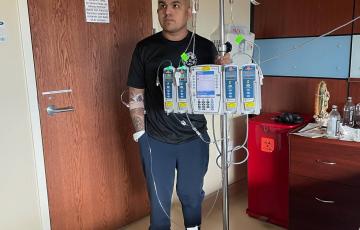Search Results

Paul & Lynn
In 2017, after 44 years of working in the railroad industry, Paul Sauter was just starting to enjoy his retirement, when his health started to decline out of nowhere. Typically, he was in extremely good shape and enjoyed long hikes with his wife, Lynn. One day, while on a mountain climb trip in Arizona, Lynn was concerned when she noticed Paul was not his usual athletic self. When he was unable to get out of bed because of severe back pain, she knew something wasn’t right.

Santino
I know the pain of being told that you have cancer twice, but I also know the joy of being told that you have beaten cancer twice. I write this message to bring encouragement and to instill a fight in people who have had a relapse of cancer. Being told once that you have this disease is already heartbreaking, but to be told that it came back and you will need chemo again is soul-crushing.

Jamiee
During COVID, I completed my graduate degree. This was in 2020, and things started to look up. Not only did I become the first member of my family to achieve a graduate degree, I also did it pregnant. I welcomed my second child in 2020, two months after graduation. In 2021, once the world settled a bit, I began to go on a healing journey where I started working on my mental and physical health. It was amazing, I finally began feeling great about myself, had the stamina to enjoy my children, and was in a career I loved.

Russ
Shockingly I was diagnosed with acute myeloid leukemia (AML) on February 28, 2024! My wife Nancy and I were devastated and had zero background or experience with leukemia. We were sent to UCLA for treatment. What a godsend!
Be Your Child’s Advocate
Parents may need to educate other family members, friends, school personnel and healthcare providers about long-term and late effects. Here are some steps parents can take:
Chemotherapy and Drug Therapy
The main treatment for active myeloma is systemic drug therapy (meaning the drugs travel through the bloodstream to kill malignant cells). The initial therapy, or “induction therapy,” for myeloma usually includes a combination of targeted agents and/or standard chemotherapy. This therapy is often followed by stem cell transplantation in eligible patients.
Common drugs combinations for people with newly diagnosed myeloma include:
Treatment Outcomes
With the current advances in treatment and supportive care, survival rates for myeloma patients have improved significantly in the last decades. It is not unusual for myeloma patients to live for 10 years or longer after diagnosis. Outcomes are influenced by a series of patient-specific factors, including disease stage, chromosome abnormalities, age and presence of other medical problems. Patients should discuss their own potential outcomes with their doctors.
Click here to access myeloma survival statistics.

Israel
I am 39 years old, a father of two boys and one girl ― Abdias, 12 years old; Ester, 10 years old; and Ben, 9 years old ― and a husband to my wife Erin for almost 14 years.
On August 14, 2021, I suffered a serious knee injury playing basketball which inadvertently led to revealing I had a blood cancer called chronic myeloid leukemia (CML). Suddenly, instead of prepping for knee surgery, I was sent to the hospital and received an official diagnosis on September 9 after a bone marrow biopsy and what felt like a million tests.

Crystal
My story starts in early December 2024. I had been getting sick a lot that year, and it finally struck me as odd when it just wouldn’t go away. I had this intense pressure in my chest as if something was sitting on top of it. Something felt wrong. I finally realized I had to go in and get checked out; I could no longer ignore my body. Early one morning, I went to urgent care, figuring I might have pneumonia or a chest infection and that I’d be sent home with some medication.

Teresa
It took two months for the doctors to take my illness seriously. I was suffering from hip and leg pain, but the doctors thought it was caused by the sports I was playing in high school. They would send me home with pain medication.

Lyndi
In March 2019 I began feeling off...I didn't know what it was. I thought perhaps it was a loss of relationship that broke me to my core, or that fact that an old friend had asked me to be kidney donor for someone I had never know. I agreed to be tested to see if I was a possible match. Fast forward to October when I was tested a possible blood clot that had formed from all of this. I was having continual pain in my right shoulder blade.

Ariana
In the blink of an eye, our lives can crumble underneath us like a tsunami drowning the life out of a city. Many of us unknowingly stand on the edge of an eroding cliff and one slip away from relinquishing our most desired aspirations. At 19 years old, I stood inches away from the edge of that cliff when I was diagnosed with essential thrombocythemia (ET). This was one of the most defining moments in my life that propelled me into a tenacious desire to become a physician capable of fully understanding the fragility of life.
Talking About Cancer
Telling people about your diagnosis is a very personal decision. Some people with cancer choose to tell only close family. Others find it helps to let more people know about their diagnosis. Take some time to consider what and how much you would like to share about your diagnosis and how you want to share this information. By letting friends and family know about your diagnosis, you give them the chance to offer their support.
Here are some tips and things to keep in mind when telling someone about your diagnosis:
Diagnosis
An accurate diagnosis of the type of leukemia is important. The exact diagnosis helps the doctor to
- Estimate how the disease will progress
- Determine the appropriate treatment
After your doctor or clinician takes your blood, he or she sends it to a lab for a complete blood count (CBC), which shows the number of red cells, white cells and platelets in your blood.
#TILTCANCER - Start Your Charity Stream Today
#TiltCancer is The Leukemia & Lymphoma Society’s gaming & esports program. Join us and our community of content creators by creating a Livestream fundraiser, sign up for our video game fundraising events or become a #TiltCancer ambassador.
Chronic Myeloid Leukemia
Chronic myeloid leukemia (CML)- Is a cancer of the bone marrow and blood
- CML is usually diagnosed in its chronic phase when treatment is very effective for most patients
- CML has three phases
Click here to access CML statistics.
Infections
Cancer patients, especially those undergoing chemotherapy, are more likely to get infections because of their weakened immune systems. Cancer and certain cancer therapies can damage the immune system by reducing the number of infection-fighting white blood cells. Patients with a low white blood cell count are at a higher risk of developing infections, and these infections can be more serious and harder to treat. In severe cases, infections can lead to death.
Pain
A cancer diagnosis does not mean that you will have pain. Still, many people with cancer do have pain at some point. Good pain control is part of proper cancer care.
Managing pain may result in better treatment outcomes, so patients should talk to their healthcare team about their pain right away. Left untreated, pain can:
Dating, Sexuality & Intimacy
As a young adult you may be dating, in a relationship, or married. Cancer can make navigating romantic relationships complicated.
DatingDating can be intimidating no matter your situation. Remember, every date before your diagnosis probably did not go perfectly. You may have bad dates after your diagnosis as well. You may also meet incredible, new people.
Chemotherapy
Chemotherapy is the main treatment for ALL. The phases of treatment include the following:
Induction TherapyThe first phase of chemotherapy is called “induction therapy.” Induction therapy
Diagnosis
While certain signs and symptoms may indicate that a person has ET, a series of tests are needed to confirm the diagnosis. It is important to have an accurate diagnosis, as it helps the doctor to:
- Estimate how the disease will progress
- Determine the appropriate treatment
Some of these tests may be repeated both during and after treatment to evaluate its effectiveness.
Treatment
Polycythemia Vera (PV) is a chronic disease: It's not curable, but it can usually be managed effectively for very long periods. The goal of therapy is to reduce the risk of thrombosis and to ease symptoms by lowering the number of extra blood cells.
Many treatment options are designed to manage PV by lowering hematocrit levels below 45 percent for men and 42 percent for women. Careful medical supervision and therapy is important to keep the hematocrit concentration at normal levels.
Simantinee
It started when I was in my second year of studying engineering with a small lump on my neck. Dad's suspicion got me to the procedure room the next morning for a biopsy. My father, Dr. Promothesh Roy (Dr. P Roy), a renowned E.N.T surgeon in the North East part of India, didn't feel it was ethical to do an incision on me (hindsight, I wish he did, he probably would have taken out the right sample at that time). Instead, he asked another colleague to do the biopsy. They didn't find anything at that time.